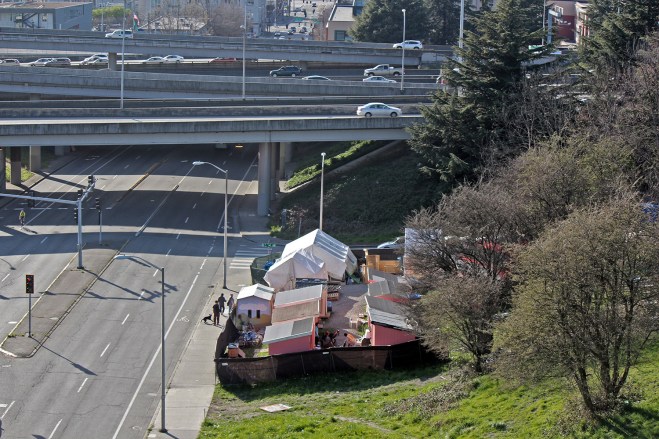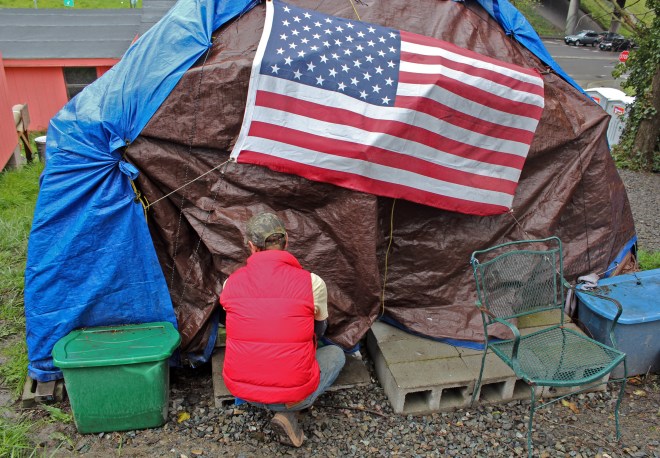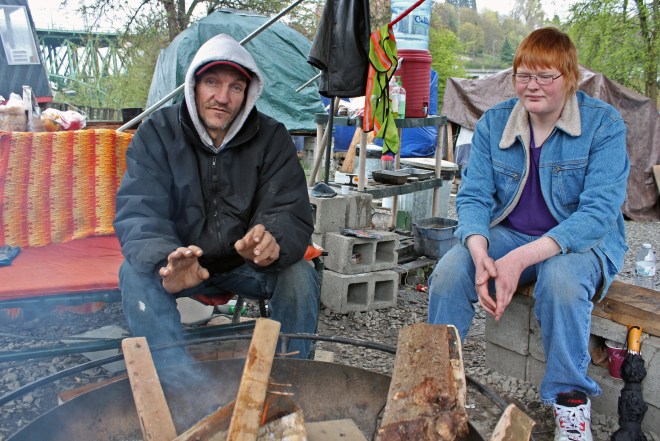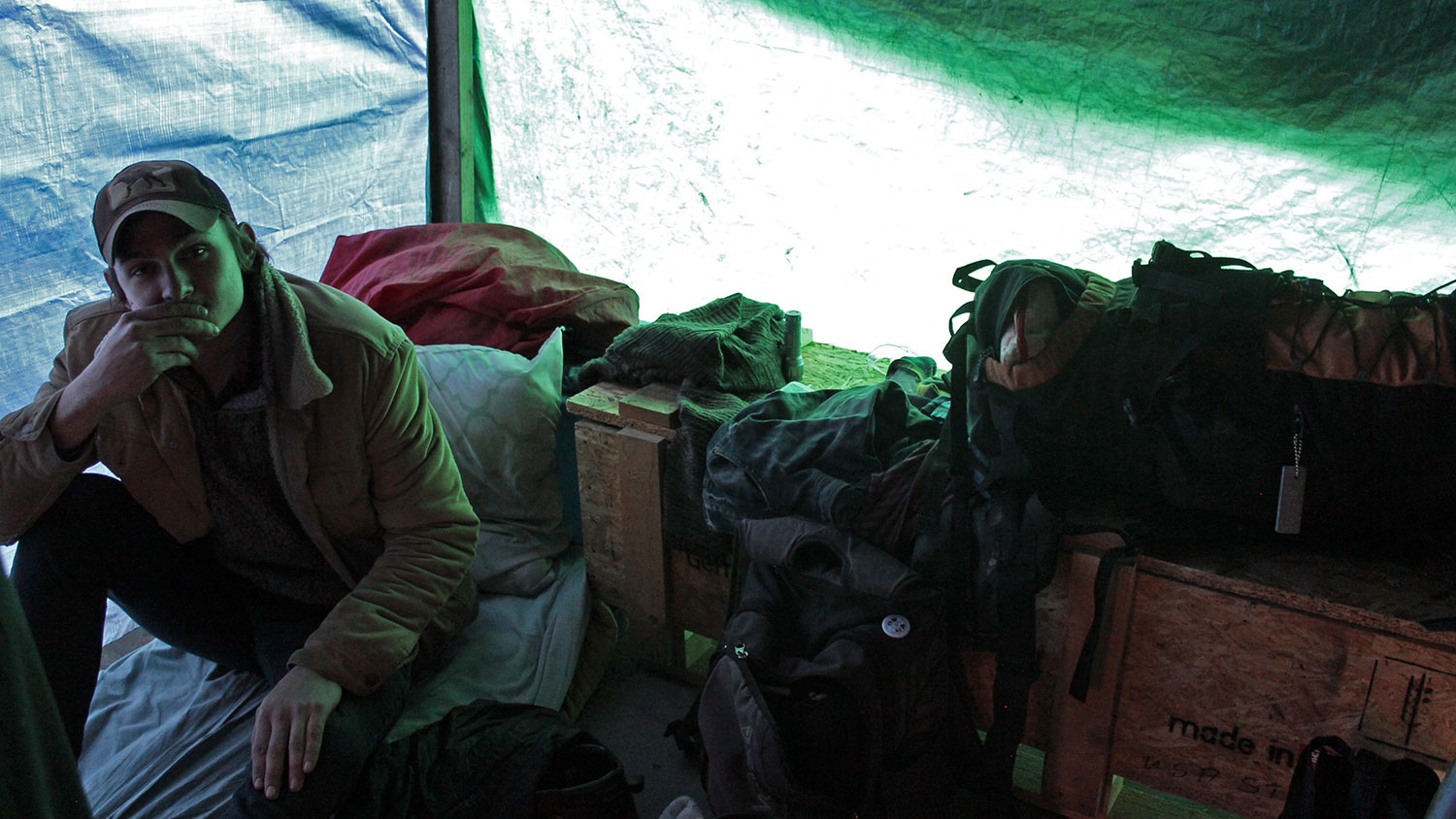Asa Yoe is a mild-mannered 30-year-old with boyish features and warm eyes. He’s from Georgia, speaks with a gentle, Southern twang, and usually has a cigarette hanging from the corner of his mouth. He makes good money fishing in Alaska every summer, then heads south every fall to pick up the odd construction job.
And that life works well, most of the time. There’s just one hitch. When Yoe was 19 and still in high school, he was convicted of a felony. It was a drug possession charge, the nonviolent kind – the kind that can get expunged if you pay up. So he did: Five years after the conviction, he paid a lawyer two grand to get the crime removed from his record. It didn’t work. To this day, the smirch makes it nearly impossible to sign a lease – and therefore rent a place of his own. He resorts, instead, to crashing at friends’ places or living with a girlfriend.
[grist-related-series]
But last fall, when Yoe got back from Alaska, he had no place to go. He had money in the bank, but no landlord would take him. He and a fishing buddy, Darby, piled into his pickup and took to the open road, sleeping in the truckbed, setting up a tent now and again, trying to find a place to call home until next fishing season. They ended up in Seattle, parked at a curb one evening, and minutes after they put their heads on their forearms, someone was calling the cops.
The next day, Yoe and Darby found Nickelsville.

Sara Bernard
Nickelsville is one of several roving tent cities in Seattle. Christened in a deliberate slam against Seattle’s former mayor, Greg Nickels, whose administration regularly cleared homeless encampments, it has relocated about 20 times since its creation in 2008.
Today, at the corner of 10th and Dearborn, a few hundred yards from the I-5 overpass, a cluster of tents and tiny houses painted flamingo pink huddle together against the Seattle chill, bright splotches of color under a dove-gray sky. The houses were built by Home Depot Foundation volunteers. The pink paint pays homage to the encampment’s original tents, which were donated by the Girl Scouts.
Amid the March drizzle, I trail Yoe as he trudges comfortably around the property in muddy boots, calling out friendly hellos to his neighbors as they peer from tent flaps or slowly pick up another log to throw on the communal campfire.
It’s a Sunday, so some workaday residents are off taking care of important life tasks, such as bathing. There’s a small bank of Porta-Potties here, but no showers, no electricity (except when there’s enough gas to power up a generator), and no water. A neighboring electric car dealership usually lets Nickelsville residents stop by and fill up water-cooler jugs for drinking and cooking, and nonprofits and churches donate bottled water, but it’s inconsistent. Yoe tells me that at one point, they were out of water for five days.
But because there are tents and wooden structures, Nickelodeons, as the 40-odd residents call themselves, have roofs over their heads. And because residents take turns working security and maintaining the property and running weekly consensus meetings, they’ve got somewhere to feel safe, to feel welcome, and to call home — at least for a little while.
Seattle allows them to stay in their current location because they are sponsored by a faith organization — this time, it’s the Lutheran Church of the Good Shepherd — as well as permission from a private landowner. The permit should last until September, when, most likely, they’ll have to find another scrap of underutilized land and move on.
The homeless camp out on the streets in Seattle and across the country, but they usually do so illegally, with fear of arrest or violence. (So far in 2015, at least 20 homeless people have died on Seattle streets; in mid-March, a woman was shot and killed while sleeping in a tent less than half a mile from Nickelsville.) But Nickelsville’s bylaws stipulate that it is clean and sober. Weapons and violence are not tolerated.
And there’s a ready openness to the culture here. It’s a family, albeit at times a dysfunctional one. People look out for one another. And many are eager to help transform the face of homelessness. “Yeah, a lot of us have our own problems,” Yoe told me with a shrug. “But everyone does. We’re not monsters.”

Asa YoeSara Bernard
The Seattle metropolitan area has the fourth-largest homeless population in the nation, trailing only New York, Los Angeles, and Las Vegas. And it’s growing: Between 2014 and 2015, the numbers of unsheltered homeless shot up by 21 percent, to 3,772, according to the Seattle/King County Coalition on Homelessness’ annual One Night Count. And those numbers are low, homeless advocates insist, because the Night Count can’t cover all areas, and because a lot of the unsheltered homeless take care not to be seen.
A sad truth: 2015 marks the 10th year of King County’s Ten-Year Plan to End Homelessness — and the numbers are now higher than they have ever been.
There are at least 243 similar plans nationwide, but not many have seen much success, says Eric Tars*, senior attorney at the National Law Center on Homelessness and Poverty, in part because of the increasingly obvious elephant in the room: a lack of affordable housing. Tars, like many advocates for the homeless, makes a convincing point: “We know how to end homelessness. Housing ends homelessness.”
Many Seattle-based advocates echo Tars, claiming the city’s numbers have a lot to do with Seattle’s rapid growth, which has resulted in colossal rent hikes and the unrelenting cycles of gentrification and displacement. Things have gotten so urgent that members of the Seattle City Council are proposing some form of rent control — famously controversial and, for the most part, still illegal in the state of Washington.
“People can’t afford their housing,” says Sharon Lee, executive director of the Low Income Housing Institute, a nonprofit that’s been an active financial and political supporter of both tent cities in general and Nickelsville specifically. “They just can’t afford it. And we find many people who end up in tent cities — Nickelsville in particular — who were evicted. Or they came here looking for work and all of a sudden they lost their job and then they’re homeless.”
Semi-formal encampments like Nickelsville aren’t unique to the Seattle area. There are at least four in Seattle or King County right now, and at least a hundred more around the nation, according to a 2014 report on the rise of tent cities in the U.S. that Eric Tars co-edited. Most are tolerated only for a short time before being broken up, says Tars; in December, San Jose, Calif., scattered what had been largest tent city in the country, a 300-person camp known as The Jungle.
Seattle has become one of very few U.S. cities to not only acknowledge encampments, but to build more of them.

Sara Bernard
In late 2014, Mayor Ed Murray convened the Emergency Task Force on Unsheltered Homelessness, and by January, had proposed an ordinance that would sanction three more tent cities within Seattle limits. The ordinance, which passed unanimously in March, will allow up to 100 people to live in each new encampment for up to a year.
For now, tent cities are relegated to non-residential areas, but a hot-button amendment authorizes the council to study the possibility of siting them in residential neighborhoods. The ordinance earmarks $70,000 for social services at the camps in 2015, and permits them to stay without sponsorship from a faith organization, which had been the previous rule.
Of course, even supporters admit that 300 tent city spots make a mere dent in the thousands of unsheltered homeless in King County. (“It’s a drop in the bucket — but it’s something,” says Yoe.) Homeless shelters pick up some of the slack, but they come with their own drawbacks: Many shelters require that people line up at night and leave in the morning, making it difficult to keep appointments or jobs or possessions; male-female couples have a difficult time staying together, since most shelters are separated by gender; and families with kids have a hard time staying together, too, for the same reason (husbands and boyfriends are not welcome at most of the shelters that house women and children).
Tent cities provide an additional option for couples and families – and people who simply don’t feel safe or comfortable in shelters. They also create stability and safety for people who would otherwise be caught in the intricate web of often-contradictory laws that criminalize activities that are a simple matter of survival for homeless people: sleeping in parks or on benches overnight, building unauthorized shelters, urinating in public.
These laws make up what Sara Rankin, an associate professor at Seattle University School of Law and director of the Homeless Rights Advocacy Project, calls “a very well-established trend of trying to push poor people out of public spaces.” These people are being penalized “just for existing,” she says.
Rankin and her students just released a series of in-depth policy briefs on such laws in the state of Washington. Among other things, the reports find that, since 2000, Washington has found 288 new ways to make it illegal to live on the street. This can throw otherwise law-abiding people into the criminal justice system, Rankin says, “not only making it more difficult for people to get out of homelessness, but ensuring that they stay there.”
And that’s one argument for sanctioning tent cities: Barring the elimination of these laws, it’s a way to stop punishing people for being homeless.

Asa’s tentSara Bernard
Cities around the country are trying other, novel ways to reduce homelessness: Utah, for instance, has seen an astonishing 72 percent drop in its numbers of chronically homeless, thanks to a policy called Housing First, which offers homeless individuals permanent supportive housing, no strings attached. (Seattle has tried this approach on a smaller scale.) Similar programs, like one in Charlotte, N.C., show comparable results. Not only does the approach reduce chronic homelessness, it also saves cities and states money they would otherwise spend on health care and law enforcement.
A federal plan to end veteran homelessness has also seen some progress: There’s been a 33 percent decrease in homeless veterans since 2010.
And a few cities are trying approaches similar to Seattle’s, says Tars. Eugene, Ore., has now sanctioned one semi-encampment, a tiny-home community called Opportunity Village, and legalized car camping. There’s also an encampment called Camp Hope in New Mexico that’s supported by five local agencies and sanctioned by the city of Las Cruces.
Still, says Tars, these encampments should not be seen as a permanent solution. “People living in encampments are still homeless,” he says. “The fact that tent cities exist in our country — which, despite the recession, remains the richest country in the world — should be seen as a local and national shame.”
“The real answer to the problem,” Rankin reiterates, “is affordable housing.” If a tent is seen as housing, she argues, then cities may feel like encampments are an adequate response to homelessness and the lack of affordable housing.*
But Low Income Housing Institute case manager Charese Jones says that’s not true. She says she moves at least one Nickelsville resident into indoor housing each month.
“We’ve demonstrated that tent cities are viable as a crisis response,” says Sharon Lee, the institute’s director. “Tent cities can be safe. They can house hundreds of people we can then move quickly into stable housing.”

Chris Semrau and another Nickelsville resident warm themselves by a communal fire.Sara Bernard
We’re gathered around the campfire — the only place to be, really, in this relentless, cold drizzle — cooking up what Nickelsville resident Chris Semrau calls “cowboy coffee,” a handful of grounds boiled over the flames in a rusted red-and-blue teapot. Half a dozen Nickelodeons, including Yoe, are sitting on logs and plastic chairs, snacking on days-old pastries, laughing, and teasing one another like family, holding gritty hands up to the flames.
After a while, Erica Semrau looks at me and asks, with sad eyes and furrowed brows, “OK, let me ask you something. If you were homeless, would you come here?”
I look around at the sturdy structures, the campfire, the camaraderie. There’s a lot of unused space, even in fast-growing Seattle, and Nickelsville seems like a way better deal than trying to make it on the street. Can Seattle’s encampments serve as an example, like Housing First in Utah, of something that works? Or is this just another stop-gap designed to ignore the root causes of poverty?
“Yes,” I say. “Absolutely, I would.”

Sara Bernard
*Correction: An earlier version of this article misspelled Eric Tars’ last name and incorrectly summarized Sara Rankin’s stance on encampments. Grist apologizes for the errors.


